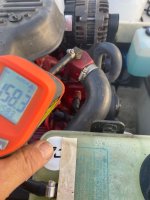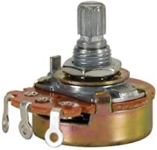MalibuMike
Petty Officer 2nd Class
- Joined
- Dec 29, 2020
- Messages
- 123
I posted a question last week about my gauge reading 180 degrees at while cruising at 3200 rpm with a closed water system. Someone mentioned that it would be a good idea to get a laser thermometer and aim it at the thermostat housing. Went to Harbor Freight and got a $30 laser gun. So I took some readings while cruising in the harbor at a very slow speed. Gauge was at 168 degrees while the laser was at 156 degrees next to the sensor ( see pics) and the highest temp I could find was 158 about 2 inches higher above the thermostat
Are gauges and sensors usually that far apart? 8 to 10 degrees seems to be a lot. How would you go about trouble shooting this to figure out how to a get a more accurate reading?
Are gauges and sensors usually that far apart? 8 to 10 degrees seems to be a lot. How would you go about trouble shooting this to figure out how to a get a more accurate reading?






















